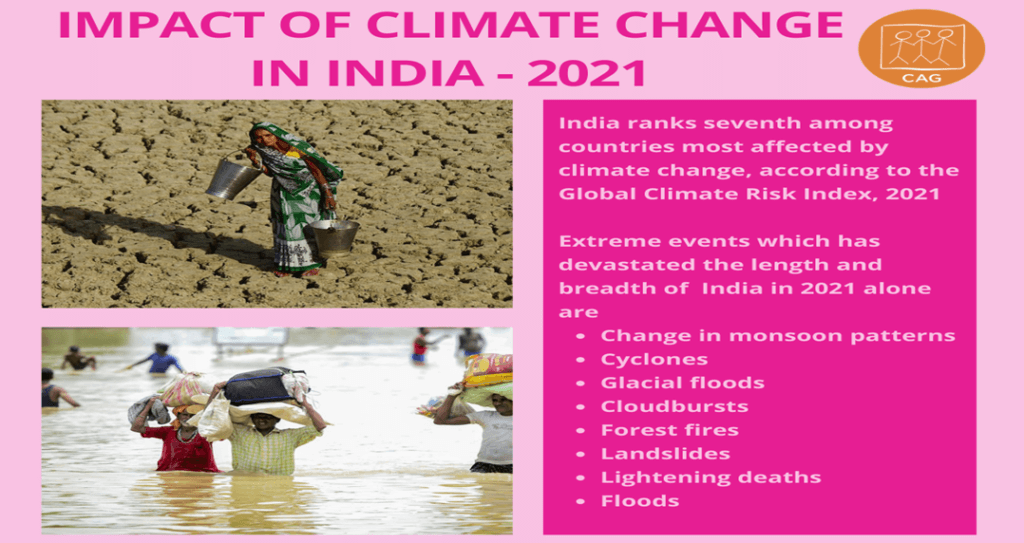Climate change is an imminent threat that demands immediate attention. The World Meteorological Organization (WMO) has recently issued a warning that global temperatures are projected to reach record levels over the next five years. This surge in temperatures is attributed to the combined effects of heat-trapping greenhouse gases and an El Niño event. The implications of extreme weather events and climate-related disasters are not only environmental but also economic. This essay explores the visible evidence of climate change, India’s vulnerability to its impacts, and the need for urgent action.
Visible Evidences of Climate Change:
- Temperature and Precipitation Anomalies:
- Rising temperatures and irregular patterns of rainfall, hail, and snow are clear indications of climate change.
- In India, the Reserve Bank of India’s report on currency and finance highlights a significant increase in the annual average temperature over the past two decades.
- The southwest monsoon has become more erratic, leading to a gradual decline in average annual rainfall.
- Increased Frequency of Dry Spells and Intense Wet Spells:
- Dry spells have become more frequent, posing challenges to agriculture and water resources.
- Conversely, intense wet spells have also increased, leading to floods and storms.
India’s Vulnerability to Climate Change:
- Exposure and Vulnerability:
- India ranks seventh in the Global Climate Risk Index 2021, indicating its exposure and vulnerability to climate-related events.
- Floods, storms (cyclones and hailstorms), and other extreme weather events pose significant risks to the country.
- Changing Structure of the Economy:
- India’s economy has undergone a transformation, with a shift from agriculture to the services sector.
- The services sector is considered emission-light, resulting in relatively lower carbon emissions.
- Sectors with high emission intensity, such as metal industries, electricity, and transportation, contribute minimally to India’s carbon footprint.
- Fossil Fuel Dependency:
- Despite the sectoral shift, fossil fuels still dominate India’s primary energy consumption, accounting for over 90%.
- This reliance on fossil fuels needs to be addressed to mitigate the impacts of climate change effectively.
Impacts of Climate Change on India:
- Economic Consequences:
- Climate change can lead to inflation, reduced economic output, increased uncertainty, and changes in consumer behavior.
- The World Bank estimated that India could experience 34 million job losses by 2030 due to heat stress-associated productivity decline.
- Sea Level Rise and Population:
- The Intergovernmental Panel on Climate Change (IPCC) identified India as one of the most vulnerable countries regarding population affected by sea level rise.
- Coastal regions and densely populated areas are particularly at risk.

The Urgency for Action:
- Physical and Transition Risks:
- Climate change poses physical risks, including gradual temperature and precipitation changes, as well as acute events like extreme weather occurrences.
- Transition risks arise from the shift toward a low-carbon economy, affecting industries, employment, and economic stability.
- GDP Impact and Net Zero Emissions:
- India’s GDP is projected to decrease by 8.5% to nearly 10% by 2050 under the current policy scenario, even if it follows its “Nationally Determined Contributions” path.
- Achieving global net-zero CO2 emissions by 2050 would result in the lowest impact on India’s GDP.
Important Points:
- Global temperatures projected to surge to record levels in the next five years 🔥
- Visible evidence of climate change:
- Anomalies in temperature and precipitation (🌡️🌧️)
- Increase in annual average temperature in India over the past 20 years (📈)
- Erratic southwest monsoon and declining annual rainfall in India (⛈️🌧️)
- More frequent dry spells and intense wet spells (🌵💦)
- India’s vulnerability to climate change:
- Exposure and vulnerability ranked seventh in the Global Climate Risk Index (🌍)
- More prone to floods and storms than droughts and heat waves (🌊🌪️)
- Shift in economy from agriculture to services sector (🌾💼)
- Relatively lower carbon emissions due to sectoral composition of the economy (📉🌿)
- Over 90% dependency on fossil fuels in primary energy consumption (⛽)
- Impacts of climate change on India:
- Economic consequences: inflation, reduced output, uncertainty, and changed consumer behavior (💰📉🌍)
- Potential job losses of 34 million by 2030 due to heat stress-associated productivity decline (👩💼🔥)
- Vulnerability to sea level rise and coastal population (🌊🏖️)
- Urgency for action:
- Physical risks: gradual temperature and precipitation changes, extreme weather events (🌡️🌧️🌪️)
- Transition risks: shift to low-carbon economy affecting industries and employment (🔄⚡)
- GDP impact and net-zero emissions:
- India’s GDP projected to decrease by 8.5% to 10% by 2050 under current policy scenario (💸📉)
- Achieving net-zero CO2 emissions by 2050 would minimize impact on India’s GDP (🌿💰)
Why In News
The World Meteorological Organization (WMO) has recently issued a concerning announcement, predicting that global temperatures are expected to soar to unprecedented heights over the next five years, posing significant challenges for our planet’s ecosystems and human populations alike. This alarming forecast serves as a stark reminder of the urgent need for collective action to mitigate climate change and protect our planet’s fragile climate system.
MCQs about Impacts for Climate Changes in India
-
What is the primary cause of the projected surge in global temperatures in the next five years?
A. Deforestation
B. Volcanic eruptions
C. Heat-trapping greenhouse gases and El Niño event
D. Solar activity
-
What is one of the visible evidences of climate change?
A. Increase in global wind speeds
B. Decrease in ocean acidity
C. Rising sea levels
D. Expansion of polar ice caps
-
What is the sectoral composition of the Indian economy that contributes to lower carbon emissions?
A. Agriculture and allied sector
B. Manufacturing sector
C. Services sector
D. Energy sector
Boost up your confidence by appearing our Weekly Current Affairs Multiple Choice Questions
![]()


